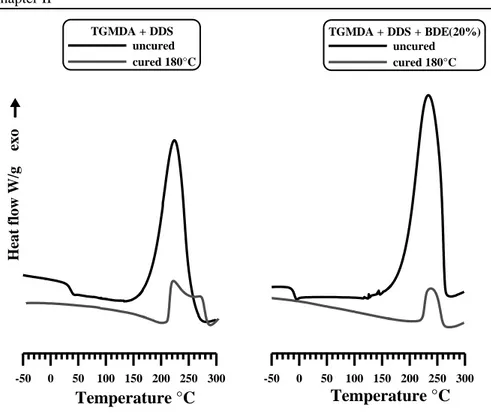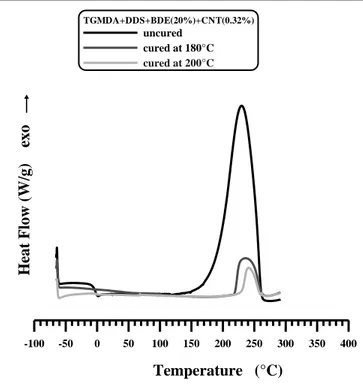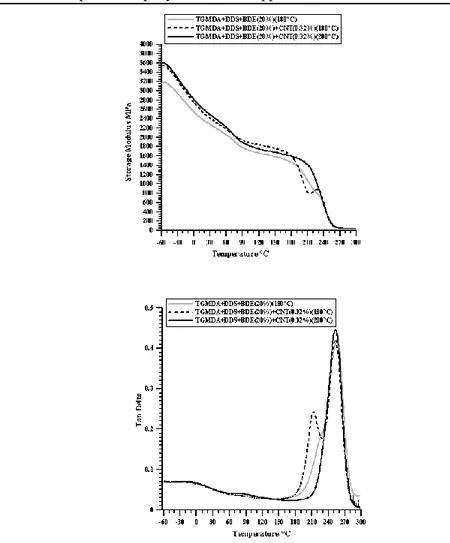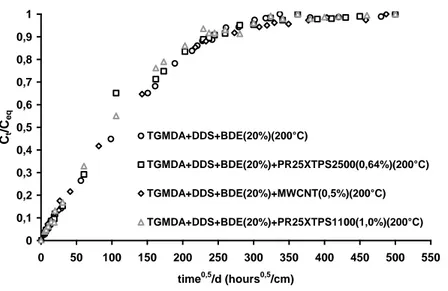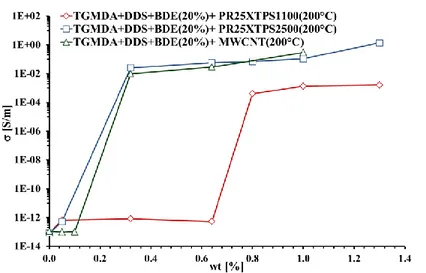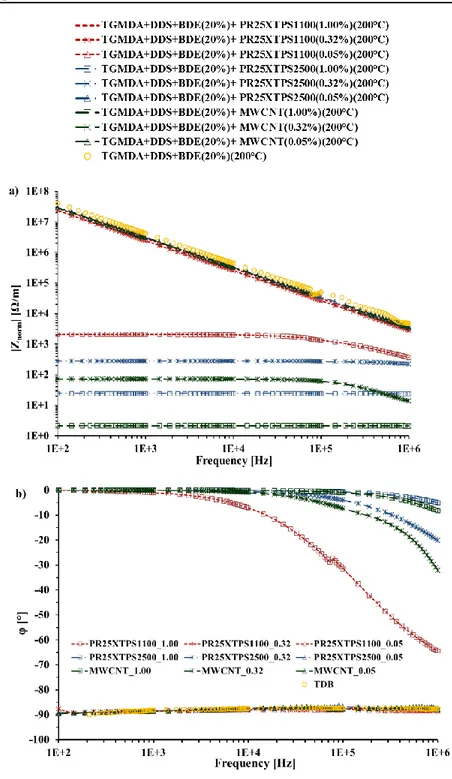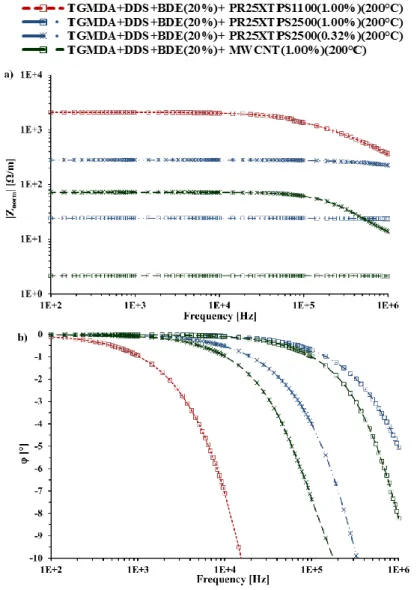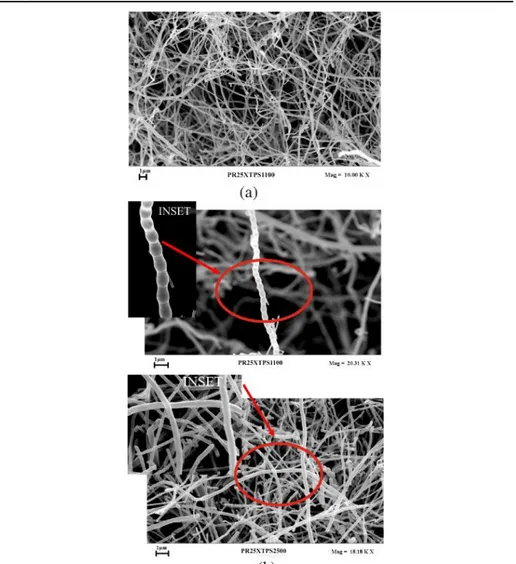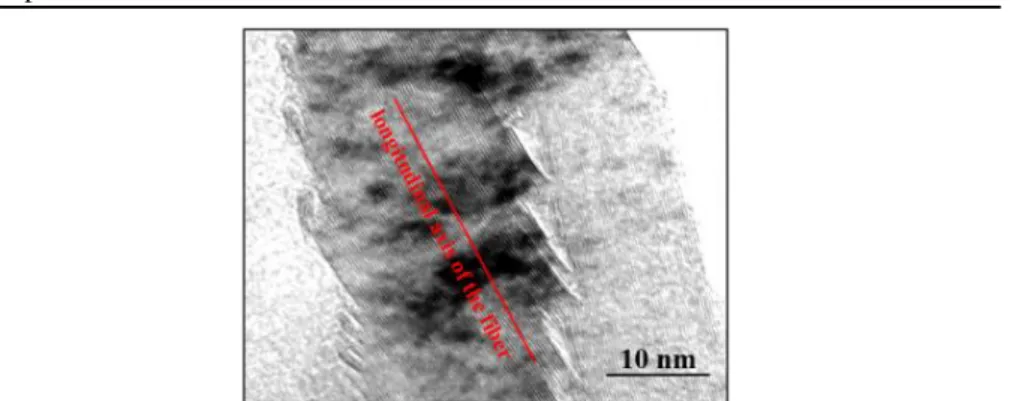Improving the aircraft safety
by advanced structures and
protecting nanofillers
Unione Europea UNIVERSITA’ DEGLI STUDI DI SALERNO
Department of Industrial Engineering
Ph.D. Course in Chemical Engineering
(XII Cycle-New Series)
Improving the aircraft safety
by advanced structures and
protecting nanofillers
Supervisor Ph.D. student
Prof. Liberata Guadagno Marialuigia Raimondo
Scientific Referees
Prof. Vittoria Vittoria
Dr. Carlo Naddeo
Prof. Vincenzo Tucci
Prof. Pasquale Longo
Ph.D. Course Coordinator
Prof. Paolo Ciambelli
UNIVERSITA’ DEGLI STUDI DI SALERNO
First and foremost I would like to express my sincere gratitude to my
supervisor Liberata (Tina) Guadagno. She taught me how it is
important to believe in themselves and how the will and tenacity may
allow to reach all the goals, even the most ambitious and difficult.
She is a role model to me, able to transmit the joy and enthusiasm she
has for her research: an excellent example of a successful woman,
scientist and professor.
I would like to acknowledge my scientific referees for their valuable
suggestions and helpful discussions.
Kind thanks to Prof. Khalid Lafdi (University of Dayton-USA) and
Prof. Maria Rossella Nobile (University of Salerno), who through a
friendly and fruitful collaboration and their specialist skills have
contributed to the success of my PhD.
I am very grateful to the IASS project (Seventh Framework
Programme, FP7/2007-2013, under Grant Agreement No.313978) not
only for the financial support but also for giving me the opportunity to
carry out a high quality research in a very professional and exciting
environment.
This work has been partly supported by POR CAMPANIA FSE
2007/2013, Asse IV e V, Reti di eccellenza tra Università -Centri di
ricerca-Imprese (linea di azione 1), MASTRI.
I would like to extend my particular thanks to all my colleagues from
the laboratory of chemistry I4.
Thanks again to all those who have supported me during these three
exciting years.
Last but not least, I would like to thank my family for all their love and
encouragement. I am especially grateful to my husband Carmine
whose unconditional love and patience are my true strength.
Thank you
Marialuigia Raimondo
University of Salerno
January 2014
Publications list related to the
Ph.D. research activity
International research papers
[1] M. Raimondo and L. Guadagno. Effect of incorporation of carbon nanotubes on the mechanical properties of epoxy-amine composites. AIP
Conferences Proceedings , 1459 (1), 226-228 (2012)
[2] B. De Vivo, L. Guadagno, P. Lamberti, M. Raimondo, G. Spinelli, V. Tucci, L. Vertuccio, V. Vittoria. Electrical properties of multi-walled carbon nanotube/tetrafunctional epoxy-amine composites. AIP Conference Proceedings, 1459 (1), 199-201 (2012)
[3] L. Guadagno, M. Raimondo, V. Vittoria, L. Vertuccio, K. Lafdi, B. De Vivo, P.Lamberti, G. Spinelli, V. Tucci. The role of carbon nanofiber defects on the electrical and mechanical properties of CNF-based resins.
Nanotechnology, 24 (30), 305704 (10pp) (2013) art. no. 305704
[4] U. Vietri, L. Guadagno, M. Raimondo, L. Vertuccio, K. Lafdi. Nanofilled epoxy adhesive for structural aeronautic materials. Composites
Part B : Engineering, 61, 73-83 (2014)
[5] L. Guadagno, M. Raimondo, V. Vittoria, L. Vertuccio, C. Naddeo, S. Russo, B. De Vivo, P. Lamberti, G. Spinelli, V. Tucci. Development of epoxy mixtures for application in aeronautics and aerospace. RCS Advances (under review)
International conferences
[1] L. Guadagno, M. Raimondo, L. Vertuccio, C. Naddeo, V. Vittoria, B. De Vivo, P. Lamberti, G. Spinelli, V. Tucci. Investigation of electrical, and dynamic mechanical properties of multi-walled carbon nanotube/epoxy composite. 11th International Workshop Nanoscience & Nanotechnology 2011 September, 19 th – 23 rd, 2011, Frascati (Italy) (book of abstracts: p. 94-99)
[2] L. Guadagno, M. Raimondo, V. Vittoria, K. Lafdi, B. De Vivo, P. Lamberti, G. Spinelli, V. Tucci. Role of The Carbon Nanotube Defects On The Electrical Properties of CNT-Based Composites. ACMA 2012, International Symposium on Aircraft Materials. May 09-12, 2012 Fez, Morocco (book of abstracts (pag.55-56) + full paper electronic format on CD, Editors: A. Menou, M. Karama, A. Moudden, A. Benejedou, A. Saouab, El Ham; ISBN:9782953480429)
[3] B. De Vivo, L. Guadagno, P. Lamberti, M. Raimondo, G. Spinelli, V. Tucci, L. Vertuccio, V. Vittoria. Electrical Properties of Multi-Walled Carbon Nanotube/Tetrafunctional Epoxy-Amine Composites. 6th International Conference on Times of Polymers (TOP) and composites. June 10-14, 2012, Ischia (Italy)
[4] M. Raimondo, L. Guadagno. Effect of incorporation of carbon nanotubes on the mechanical properties of epoxy-amine composites. 6th International Conference on Times of Polymers (TOP) and composites. June 10-14, 2012, Ischia (Italy)
[5] L. Guadagno, M. Raimondo, L. Vertuccio, C. Naddeo, V. Vittoria, B. De Vivo, P. Lamberti, G. Spinelli, V. Tucci. Electrical, and dynamic mechanical properties of MWCNTs/epoxy composite for high performance aerospace applications. ECCM 15 – 15th European Conference on Composite Materials. June 24-28, 2012 Venice-Italy ISBN:9788888785332 [6] L. Guadagno, M. Raimondo, V. Vittoria, L. Vertuccio, K. Lafdi, B. De Vivo, P. Lamberti, G. Spinelli, V. Tucci . Effect of conductive nanofiller structures on electrical properties of epoxy composite for aeronautic applications. ICEAF III 3rd International Conference of Engineering Against Failure. 26-28 June, 2013 - Kos island, Greece, Patras Spiros Pantelakis Vol.III, Pag. 527-533 ISBN:9789608810433
[7] L. Guadagno, M. Raimondo, V. Vittoria, L. Vertuccio, K. Lafdi, B. De Vivo, P. Lamberti, G. Spinelli , V. Tucci. Electrical properties of CNFs/Epoxy-Amine Resin for aeronautic and aerospace applications. ICEAF III 3rd International Conference of Engineering Against Failure. 26-28 June, 2013 - Kos island, Greece, Patras Spiros Pantelakis Vol.III, Pag.534-541 ISBN:9789608810433
[8] M. Raimondo, L. Guadagno, L. Bonnaud, O. Murariu, Ph. Dubois. Effect of Incorporation of POSS Compounds on Thermal and Fire Resistance of Aeronautic Resins. ICEAF III 3rd International Conference of Engineering Against Failure. 26-28 June, 2013 - Kos island, Greece, Patras Spiros Pantelakis Vol.III, Pag.542-550 ISBN:9789608810433
[9] M. Raimondo, L. Vertuccio, G. Barra, L. Bonnaud, O. Murariu, Ph. Dubois, S. Russo, L. Guadagno. Thermal Degradation and fire properties of epoxy modified resins. 3rd EASN Association International Workshop on AeroStructures Proc. 9th‐11th October 2013, Milan, Italy (ISSN 2309-7213)
[10] M. Raimondo, S. Chirico, L. Guadagno, P. Longo, A. Mariconda, L. Bonnaud, O. Murariu, Ph. Dubois, L. Dumas. Fire properties of TGMDA resins for aeronautic applications. 3rd EASN Association International Workshop on AeroStructures Proc.. 9th‐11th October 2013, Milan, Italy (ISSN 2309-7213)
[11] L. Guadagno, M. Raimondo, V. Vittoria, L. Vertuccio, K. Lafdì, B. De Vivo, P. Lamberti, G. Spinelli, V. Tucci. Exfoliated graphite as conductive filler in aeronautic epoxy mixtures. 3rd EASN Association International
Workshop on AeroStructures Proc.. 9th‐11th October 2013, Milan, Italy (ISSN 2309-7213)
[12] M.R. Nobile, A. Fierro, S. Rosolia, L. Guadagno, M. Raimondo. Viscoelastic Properties of CNT/Epoxy-Amine Resins for Structural Applications. NanotechITALY 2013 – 6TH edition Key Enabling Technologies for Responsible Innovation Proc., 27th – 29th November 2013, Venice, Italy.
[13] K.I. Tserpes, L. Guadagno, I. Floros, M. Raimondo and U. Vietri. Numerical modelling of nanoparticle-reinforced adhesively bonded joints. 11th World Congress on Computational Mechanics (WCCM2014), Barcelona, Spain, 20-25 July 2014 (accepted)
[14] L. Guadagno, M. Raimondo, K. Lafdi, A. Fierro, S. Rosolia, M.R. Nobile. Influence of Nanofiller Morphology on the Viscoelastic Properties of CNF/Epoxy Resins. 7th International Conference on Times of Polymers (TOP) and composites. June 22-26, 2014, Ischia (Italy) (accepted)
[15] L. Guadagno, U. Vietri, M. Raimondo, L. Vertuccio. Nanofilled Epoxy Adhesive for Metal Adherends. 7th International Conference on Times of Polymers (TOP) and composites. June 22-26, 2014, Ischia (Italy) (accepted)
[16] L. Guadagno, U. Vietri, M. Sarno, M. Raimondo, C. Cirillo, P. Ciambelli. Nanofilled epoxy adhesives for structural applications. 7th International Conference on Times of Polymers (TOP) and composites. June 22-26, 2014, Ischia (Italy) (accepted)
[17] L. Guadagno, M. Raimondo, U. Vietri, G. Barra, L. Vertuccio, R. Volponi, G. Cosentino, F. De Nicola, A. Grilli, P. Spena. Development of Multifunctional Carbon Fiber Reinforced Composites (CFRCs) - Manufacturing Process. 7th International Conference on Times of Polymers (TOP) and composites. June 22-26, 2014, Ischia (Italy) (accepted)
Italian Patents
[1] L. Guadagno, M. Raimondo, V. Vittoria, L. Vertuccio, C. Naddeo, P. Lamberti, V. Tucci. Resina epossidica con basso tenore di umidità. Filing number: TO2013A000926 Filing date: 15.11.2013
[2] L. Guadagno, M. Raimondo, P. Longo, L. Bonnaud, O. Murariu, Ph. Dubois. Resina epossidica multifunzionale con accresciuta resistenza alla fiamma.
Other publications during Ph.D.
course
International research papers
[1] L. Guadagno, P. Longo, M. Raimondo, C. Naddeo, A. Mariconda, V. Vittoria, G. Iannuzzo, S. Russo. Use of Hoveyda-Grubbs’ 2nd Generation Catalyst in Self-Healing Epoxy Mixtures. Composites Part B : Engineering, 42(2), 296-301 (2011)
[2] L. Guadagno, M. Raimondo, C. Naddeo, G. Russo, V. Vittoria, S. Russo, G. Iannuzzo. Dynamic Mechanical Properties of Structural Self-healing Epoxy Resins. Applied Mechanics and Materials, 62, 95-105 (2011)
[3] L. Guadagno, M. Raimondo, C. Naddeo, A. Di Bartolomeo, K. Lafdi. Influence of multi-wall carbon nanotubes on morphological and structural changes during UV irradiation of syndiotactic polypropylene films. J.
Polym. Sci.-Part B: Polymer Physics, 50(14), 963-965 (2012)
[4] B. De Vivo, P. Lamberti, G. Spinelli, V. Tucci, L. Guadagno, M. Raimondo, L. Vertuccio, V. Vittoria, E. Caponetti. Impact of the inclusion of hydrotalcite on the morphological and electrical characteristics of an epoxy-based CNT nanocomposites. IEEE International Symposium on
Electromagnetic Compatibility, art. no. 6396851 (2012)
[5] B. De Vivo, P. Lamberti, R. Raimo, G. Spinelli, V. Tucci, L. Guadagno, M. Raimondo, L. Vertuccio, V. Vittoria, M.S. Sarto, A. Tamburrano. Electromagnetic and Mechanical Properties of a multiphase Carbon NanoTube/Clay/Epoxy Nanocomposite. IEEE International Symposium on
Electromagnetic Compatibility, art. no. 6396809 (2012)
[6] L. Guadagno, M. Raimondo, C. Naddeo, P. Longo, A. Mariconda. Self-healing Materials for Structural Applications. Polymer Engineering and
Science Online ISSN: 1548-2634 pp 1-8 DOI: 10.1002/pen.23621 Article
first published online: 7 JUN 2013
[7] M. Raimondo and L. Guadagno. Healing efficiency of epoxy-based materials for structural application. AIP Conferences Proceedings, 1459 (1), 223-225 (2012)
[8] B. De Vivo, G. Spinelli, V. Tucci, L. Guadagno, M. Raimondo, L. Vertuccio, V. Vittoria, P. Lamberti. Improvement of the electrical conductivity in multiphase epoxy-based MWCNT nanocomposites by means of an optimized clay content. Composites Science and Technology, 89, 69-76 (2013)
[9] L. Vertuccio, A. Sorrentino, L. Guadagno, V. Bugatti, M. Raimondo, C. Naddeo, V. Vittoria. Behavior of epoxy composite resins in environments at high moisture content. Journal of Polymer Research, 20(6), 1-13 (2013) art. no. 178
[10] M. Raimondo and L. Guadagno. Healing efficiency of epoxy-based materials for structural applications. Polymer Composites, 34(9), 1525-1532 (2013)
[11] M. Raimondo, L. Guadagno, C. Naddeo, P. Longo, A. Mariconda. Efficient self-healing resins. Plastics Engineering. Pag.1-3 ISSN:0091-9578
(2013) DOI: 10.2417/spepro.004911 (web site:
http://www.4spepro.org/view.php?source=004911-2013-06-06)
[12] L. Guadagno, M. Raimondo, C. Naddeo, P. Longo, A. Mariconda, W.H. Binder. Healing efficiency and dynamic mechanical properties of self-healing epoxy systems. Smart Mater. Struct., 23(4), 045001 (11pp) (2014) [13] M. Raimondo, P. Longo, A. Mariconda, L. Guadagno. Healing Agent for the Activation of Self- Healing Function at Low Temperature. Advanced
Composites Materials (under review)
International conferences
[1] M. Raimondo, L. Guadagno, C. Naddeo. Effect of multiwall carbon nanotubes on the morphology of irradiated syndiotactic polypropylene. Workshop “Advances in Polymer based Materials and Related Technologies”. May 29th – June 1st, 2011, Capri (Italy) (book of abstracts: p. 121)
[2] L. Guadagno, M. Raimondo, C. Naddeo, R. Corvino, V. Vittoria, G. Russo, S. Russo, K. Lafdi. Composites for Self-healing Structural Materials. Workshop “Advances in Polymer based Materials and Related Technologies”. May 29th – June 1st, 2011, Capri (Italy) (book of abstracts: p. 122)
[3] G. Russo, L. Guadagno, G. W. M. Peters, M. Raimondo, R. H. M. Solberg. Electrospinning of drug-loaded mesh samples: Morphological analysis (AFM) and drug release. Workshop “Advances in Polymer based Materials and Related Technologies”. May 29th – June 1st, 2011, Capri (Italy) (book of abstracts: p. 125)
[4] M. Raimondo, R. Corvino, L. Guadagno, P. Longo, C. Naddeo, A. Mariconda. Advanced Polymeric Composites for Self-healing Structural Materials. European Polymer Congress 2011 (XII Congress of the Specialized Group of Polymers (GEP), 26th June-1st July 2011, Granada, Spain. (Book of abstracts: p. 749, ISBN: 978-84-694-3124-5)
[5] L. Guadagno, M. Raimondo. Development of self-healing epoxy nanocomposites for structural applications. 11th International Workshop
Nanoscience & Nanotechnology 2011 September, 19 th – 23 rd, 2011, Frascati (Italy) (book of abstracts: p. 103-108)
[6] G. Russo, L Guadagno, G. W. M. Peters, M. Raimondo, R.H.M. Solberg, V. Vittoria. Preparation and morphological characterization of Mesh Membranes obtained using Electrospinning technique. 11th International Workshop Nanoscience & Nanotechnology 2011 September, 19 th – 23 rd, 2011, Frascati (Italy) (book of abstracts: p. 84-88) [7] M. Raimondo, L. Guadagno. Healing efficiency of epoxy-based materials for structural applications. 6th International Conference on Times of Polymers (TOP) and composites. June 10-14, 2012, Ischia (Italy) [8] B. De Vivo, P. Lamberti, R. Raimo, G. Spinelli, V. Tucci, L. Guadagno, M. Raimondo, L. Vertuccio, V. Vittoria, M. S. Sarto, A. Tamburrano. Electromagnetic and Mechanical Properties of a multiphase Carbon NanoTube/Clay/Epoxy Nanocomposite. EMC Europe 2012. Rome. September 17-21, 2012 Rome, Italy, pp. 1-6 ISBN:9781467307178
[9] B. De Vivo, P. Lamberti, G. Spinelli, V. Tucci, L. Guadagno, M. Raimondo, L. Vertuccio, V. Vittoria, E. Caponetti. Impact of the inclusion of hydrotalcite on the morphological and electrical characteristics of an epoxy-based CNT nanocomposite. EMC Europe 2012. Rome. September 17-21, 2012 Rome, Italy, pp.1-4 ISBN:9781467307185
[10] M. Raimondo, P. Longo, A. Mariconda, L. Guadagno. Healing Agent for the Activation of Self-Healing Function at Low Temperature. ICEAF III 3rd International Conference of Engineering Against Failure. 26-28 June, 2013 - Kos island, Greece, Patras Spiros Pantelakis Vol.III, Pag.519-526 ISBN:9789608810433
[11] L. Guadagno, M. Raimondo, C. Naddeo, P. Longo, A. Mariconda, W. H. Binder. Healing Efficiency and Dynamic Mechanical Properties of self-healing epoxy systems. 3rd EASN Association International Workshop on AeroStructures Proc.. 9th‐11th October 2013, Milan, Italy (ISSN 2309-7213)
[12] B. De Vivo, L. Guadagno, P. Lamberti, M. Raimondo, G. Spinelli, V. Tucci, L. Vertuccio and V. Vittoria. Temperature Effects on the Electrical Properties of Multiphase Polymer Composites. 7th International Conference on Times of Polymers (TOP) and composites. June 22-26, 2014, Ischia (Italy) (accepted)
Book chapters
[1] L. Guadagno and M. Raimondo. Use of FT/IR analysis to control the self-healing functionality of epoxy resins. In "Infrared Spectroscopy –
Materials Science, Engineering and Technology / Book 1", Prof.
Theophile Theophanides (Editor) ISBN: 978-953-51-0537-4 chapter 14 pp 286-300 DOI: 10.5772/36029 Published Online: April 25, 2012 Publisher: InTech.
[2] L. Guadagno, M. Raimondo, C. Naddeo, P. Longo. Application of Healing Materials in Aerospace Engineering. In Wolfgang H. Binder Self-Healing Polymers: From Principles to Applications (book) Wolfgang H. Binder (Editor) ISBN: 9783527334391 chapter 17 pp 401-412 DOI: 10.1002/9783527670185.ch17 Published Online: 24 JUN 2013 Publisher: Wiley-VCH Books
US Patent Publications
[1] L. Guadagno, M. Raimondo, C. Naddeo, A. Mariconda, R. Corvino, P. Longo, V. Vittoria, S. Russo, G. Iannuzzo. Process for preparing self-healing composite materials of high efficiency for structural applications.
Patent No.: US 8481615 B2 Date of Patent: July 9, 2013 Assignee: Alenia Aeronautica S.p.A
Prior Publication Date US 2011118385 (A1) May. 19, 2011 Also published as:
EP 2325254 (A1) Publication date: November 11, 2010 IT TO20090870 (A1) Filing date: 13 novembre 2009
[2] L. Guadagno, P. Longo, M. Raimondo, A. Mariconda, C. Naddeo, A. Sorrentino, V. Vittoria, G. Iannuzzo, S. Russo, E. Calvi. Process for preparing a self-healing composite material.
Patent No.: US 8273806 B2 Date of Patent: Sep. 25,2012 Assignee: Alenia Aeronautica S.p.A
Prior Publication Date US 2010168280 (A1) Jul. 1, 2010 Also published as:
EP 2172518 (A1) Publication date: 07.04.2010 IT TO20080723 (A1) Filing date: 02 ottobre 2008
[3] L. Tammaro, L. Guadagno, M. Raimondo, O. Petillo, S. Margarucci, A. Calarco, V.Vittoria, G. Peluso. Composite material with properties of self-healing and release of active ingredients, for biomedical applications.
Publication number: US 20120208895 (A1) Publication date: August 16, 2012
Also published as:
EP 2379045 (A1) Publication date: 26.10.2011 WO 2010072347 (A1) Publication date: 01 July 2010 IT MI20082284 (A1) Filing date: 22 dicembre 2008
EP Patent Publications
[1] L. Guadagno, P. Longo, M. Raimondo, A. Mariconda, C. Naddeo, A. Sorrentino, V. Vittoria, G. Iannuzzo, S. Russo, E. Calvi. A composite material which is self-repairing even at low temperature.
Patent No.: EP2257422 B1 Date of Publication: 10.07.2013 Also published as:
EP 2257422 (A1) Publication date: 08.12.2010. WO 2009113025 (A1) Publication date: 17.09.2009 IT TO20080194 (A1) Filing date: 13 marzo 2008
[2] V. Vittoria, L. Guadagno, A. Sorrentino, M. Raimondo, C. Naddeo, L.Vertuccio, G. Iannuzzo, S. Russo, E. Calvi. Epoxy resin based
composition and method for the curing thereof.
Publication number: EP 2271706 (A1) Publication date: 12.01.2011 Also published as:
WO 2009113027 (A1) Publication date: 17.09.2009 IT TO20080191 (A1) Filing date: 13 marzo 2008
PhD School Partecipation
[1] PhD Forum– GRICU PhD National School Mathematical Methods for Chemical Engineering/Nanotechnologies
Santa Margherita di Pula (CA), 26th September – 1st October 2011 [2] GRICU PhD NATIONAL SCHOOL 2012
Transport phenomena Separation processes Montesilvano (PE) September 20th – 23rd 2012 [3] GRICU PhD NATIONAL SCHOOL 2013
Free radical polymerization: kinetics, statistical thermodynamics and engineering aspects
Advanced topics in sustainable chemical engineering Salice Terme (PV) September 15th – 21th 2013
Index
C
HAPTERI ... 1
I
NTRODUCTION... 1
I.1 Preface ... 1
I.2 State of the art and progress beyond the state of the art:
Multifunctional concept ... 6
I.3 Research strategies ... 7
I.3.1 Reduced electrical conductivity: Current technology ... 8
I.3.1.1 Research activity ... 8
I.3.2 Poor flame resistance: Current Technology ... 12
I.3.2.1 Research strategy ... 12
I.3.2.2 Motivation of the chosen work strategies ... 13
C
HAPTERII ... 19
D
EVELOPMENT OF EPOXY MIXTURES FOR APPLICATION IN AERONAUTICS AND AEROSPACE... 19
II.1 Preface ... 19
II.2 General remarks ... 19
II.3 Experimental section ... 22
II.3.1 Materials and sample preparation ... 22
II.3.2 Methods ... 23
II.3.3 Results and discussions ... 25
II.3.3.1 Choice of the curing cycle: Thermal analysis ... 25
II.3.3.2 Dynamic Mechanical Results ... 27
II.3.3.3 Water Transport Properties... 30
II.3.3.4 Thermogravimetric analysis ... 33
II.3.3.5 Morphological investigation ... 35
II.3.3.6 Electrical Behavior ... 39
II.3.3.6.1 Dielectric properties of the resin ... 39
II.3.3.6.2 DC conductivity of nanofilled resins ... 41
II.3.3.7 Impedance spectroscopy of nanocomposites ... 44
II.4 Conclusions ... 48
C
HAPTERIII ... 51
R
OLE OF THECNF
DEFECTS ON THE ELECTRICAL AND MECHANICAL PROPERTIES OFCNF-B
ASEDR
ESINS... 51
II
III.2 General remarks ... 52
III.3 Experimental section ... 53
III.3.1 Materials ... 53
III.3.1.1 Carbon nanofibers ... 53
III.3.1.2 Nanofilled Epoxy Resins ... 54
III.3.2 Characterizations ... 54
III.3.3 Results and discussion ... 55
III.3.3.1 Carbon nanofibers characterization ... 55
III.3.3.1.1 Morphological and structural investigation ... 55
III.3.3.1.2 Structural investigation ... 58
III.3.3.1.3 Raman and FT/IR spectroscopy ... 59
III.3.3.1.4 Thermogravimetric analysis ... 61
III.3.3.2 CNF/epoxy resin characterization ... 62
III.3.3.2.1 Thermogravimetric analysis ... 62
III.3.3.2.2 Morphological analysis ... 63
III.3.3.2.3 Electrical behavior ... 64
III.3.3.2.4 Dynamic mechanical properties ... 67
III.4 Conclusions ... 68
C
HAPTERIV ... 71
V
ISCOELASTICP
ROPERTIES OFCNT/E
POXY-A
MINER
ESINS FORS
TRUCTURALA
PPLICATIONS... 71
IV.1 General remarks ... 71
IV.2 Materials and Methods ... 72
IV.3 Results and discussion ... 72
IV.3.1 Rheological, dynamic mechanical and morphological properties ... 72
IV.4 Conclusions ... 76
C
HAPTERV ... 77
I
NFLUENCE OFN
ANOFILLERM
ORPHOLOGY ON THEV
ISCOELASTICP
ROPERTIES OFCNF/E
POXYR
ESINS... 77
V.1 General remarks ... 77
V.2 Materials ... 78
V.3 Morphological analysis ... 79
V.4 Rheological analysis ... 79
V.5 Conclusions ... 81
C
HAPTERVI ... 83
E
XFOLIATED GRAPHITE AS CONDUCTIVE FILLER IN AERONAUTICEPOXY MIXTURES
... 83
VI.1 Preface ... 83
VI.2 General Remarks ... 83
VI.3 Material and Experimental Part ... 85
VI.4 Methods ... 86
VI.5 Results ... 87
VI.5.1 Carbon nanofiller characterization (Raman Spectroscopy) . 87 VI.5.2 Exfoliated graphite and epoxy/exfoliated graphite nanocomposites: X-Ray Diffraction Analysis ... 88
VI.5.3 Epoxy/exfoliated graphite nanocomposites: Dynamic Mechanical Analysis ... 89
VI.5.4 Epoxy/exfoliated graphite nanocomposites: Electrical Characterization ... 90
VI.5.5 Exfoliated graphite and epoxy/ exfoliated graphite nanocomposites: Morphological investigation ... 92
VI.6 Conclusions ... 95
C
HAPTERVII ... 97
F
IRE RETARDANCY CONCEPTS... 97
VII.1 Preface ... 97
VII.2 Polymer combustion ... 97
VII.2.1 Mechanism of action ... 99
VII.2.1.1.Chemical Effect Condensed Phase ... 101
VII.2.1.2 Intumescence ... 102
VII.2.1.3 Chemical Effect Gas Phase ... 103
VII.2.1.4 Synergism with Antimony trioxide (Sb2O3) ... 104
VII.2.1.5 Physical Effect ... 105
VII.2.1.5.1 Formation of a protective layer ... 105
VII.2.1.6 Cooling effect ... 105
VII.2.1.7 Diluition ... 105
C
HAPTERVIII ... 107
E
FFECT OFI
NCORPORATION OFPOSS
C
OMPOUNDS ONT
HERMAL ANDF
IRER
ESISTANCE OFA
ERONAUTICR
ESINS... 107
VIII.1 Preface ... 107
VIII.2 General remarks ... 107
IV
VIII.3.1 Materials ... 112
VIII.3.2 Characterizations and Experimental procedure ... 112
VIII.4 Results and discussion ... 114
VIII.4.1 Dispersion of POSS inside the epoxy mixture ... 114
VIII.4.1.1 Results on the dispersion of DPHPOSS in the epoxy mixture. 115 VIII.4.1.2 Results on the dispersion of ECPOSS in the epoxy mixture .... 116
VIII.4.1.3 Results on the dispersion of GPOSS in the epoxy mixture ... 117
VIII.4.1.4 Results on the dispersion of TCPOSS in the epoxy mixture .... 118
VIII.4.2 Thermogravimetric analysis ... 119
VIII.4.3 Fire behavior of POSS/EPM ... 120
VIII.5 Conclusions ... 121
C
HAPTERIX ... 123
M
ULTIFUNCTIONAL EPOXY RESIN WITH ENHANCED FLAME RESISTANCE... 123
IX.1 General remarks ... 123
IX.2 Synthesis of new hardener agents ... 127
IX.2.1 Materials ... 127
IX.2.2 Characterization ... 127
IX.2.3 Synthesis procedure of BAPPO ... 128
IX.2.4 Synthesis procedure of BAMPO ... 131
IX.3 Thermal and oxidative degradation of BAPPO and
BAMPO ... 138
IX.4 Dissolution of BAMPO and BAPPO in epoxy matrix ... 141
IX.5 Evaluation of the BAPPO and BAMPO as hardeners for
improving fire properties ... 145
IX.5.1 Materials ... 145
IX.5.2 Sample preparation ... 145
IX.5.3 Characterizations ... 146
IX.6 Conclusions ... 152
C
HAPTERX ... 153
D
EVELOPMENT OFM
ULTIFUNCTIONALC
ARBONF
IBERR
EINFORCEDC
OMPOSITES(CFRC
S)
-
M
ANUFACTURINGP
ROCESS... 153
X.1 Preface ... 153
X.2 General remarks ... 153
X.4 CFRCs –Manufacturing Process ... 154
X.5 Results and discussion ... 156
X.6 Morphological investigation ... 157
X.7 Conclusions ... 158
G
ENERAL CONCLUSIONS... 159
List of figures
Figure I.1 Catastrophic damage from a lightning strike on an airliner ... 1 Figure I.2 Growth of Composites in Commercial Jets ... 2 Figure I.3 China Airlines jet exploded in flames ... 3 Figure I.4 Schematic of multiscale concept: from nanomaterials to new-concept aircrafts ... 5 Figure I.5 Top-down methods for production of graphene and modified graphene starting from graphene or via graphene oxide (GO) ... 11 Figure I.6 Synthesis scheme of chemically reduced graphite oxide ... 12 Figure I.7 Scheme of research strategies ... 13 Figure I.8 Structural formula of bis(3-aminophenyl)methylphosphine oxide and bis(3 aminophenyl)phenylphosphine oxide ... 14 Figure I.9 Generalized structure of a POSS material ... 16 Figure I.10 4,4′-Diaminodiphenyl sulfone (DDS) and
bis(3-aminophenyl)phenylphosphine oxide (BAPPO) ... 16 Figure II.1 Chemical structures of compounds used for the epoxy matrix composite ... 22 Figure II.2 DSC curves of: a) the uncured and cured epoxy resin TGMDA+DDS (without reactive diluent) on the left side, and b) the uncured and cured epoxy mixture TGMDA+DDS+BDE(20%)(TGMDA with reactive diluent/DDS) on the right side ... 26 Figure II.3 DSC curves of: the uncured epoxy mixture
TGMDA+DDS+BDE(20%)+CNT(0.32%), and the same epoxy mixture cured by two different curing cycles ... 27 Figure II.4 Storage modulus (MPa) (at the top), and Loss factor (tanδ) (at the bottom) of the pure epoxy and the composites 0.32 wt% MWCNTs solidified up to 180 and 200°C respectively ... 29 Figure II.5 The concentration at time (Ct) as a function of the time (hours) of the
epoxy resin (without BDE), and the epoxy mixture containing the diluent ... 31 Figure II.6 Ct/Ceq against the square root of time of unfilled and nanofilled mixtures ... 32 Figure II.7 Thermogravimetric curves in air of: a) the uncured and cured unfilled epoxy resin TGMDA/DDS (without reactive diluent) on the left side, and b) the reactive diluent BDE on the right side ... 34 Figure II.8 Thermogravimetric curves in air of : a) the uncured and cured unfilled epoxy mixture TGMDA+DDS+BDE(20%) (TGMDA with reactive diluent/DDS) on the left side, and b) the same epoxy formulation nanofilled with a percentage of 0.32% of MWCNTs on the right ... 34 Figure II.9 Fracture surface SEM images of the nanofilled epoxy composites at loading rate of A) 0.64, B) 0.32 and C) 0.05 per cent by weight of CNTs ... 36 Figure II.10 TEM image of sample B (epoxy resin at loading rate of 0.32 per cent by weight of CNTs) ... 36 Figure II.11 Fracture surface SEM images of the nanofilled epoxy composites at loading rate of 0.64 per cent by weight: as received CNFs filled resin is on the top, heat-treated CNFs filled resin is on the bottom ... 37
II
Figure II.12 Fracture surface SEM images of the nanofilled epoxy resins at loading rate of 1.0 per cent by weight: as received CNFs filled resin is on the top, heat-treated CNFs filled resin is on the bottom ... 38 Figure II.13 Fracture surface SEM images (enlargement) of the nanofilled epoxy resins at loading rate of 1.0 per cent by weight: as received CNFs filled resin is on the top, heat-treated CNFs filled resin is on the bottom ... 38 Figure II.14 AC behaviour of the relative electric permittivity for the TGMDA epoxy formulations (with and without diluent) compared with the formulation based on DGEBA at T=30°C ... 40 Figure II.15 AC behaviour of the electrical conductivity for the TGMDA epoxy formulations (with and without diluent) compared with the formulation based on DGEBA at T=30°C ... 41 Figure II.16 DC volume conductivity of the nanofilled composites as a function of the nanofiller concentration ... 42 Figure II.17 Plot of the log of conductivity against ϕ-1/3 ... 43 Figure II.18 Normalized impedance a) and phase angle b) vs frequency ... 46 Figure II.19 |Znorm| and φ vs frequency for composites at filler loadings beyond
percolation threshold ... 47 Figure III.1(a) An SEM image of as-received CNFs (PR25XTPS1100); (b) SEM images of as-received CNFs (PR25XTPS1100) and CNFs heat treated at 2500°C (PR25XTPS2500); the inset shows higher magnifications for each sample ... 56 Figure III.2 Bright field micrograph of the 'Dixie cup' carbon nanofiber structure on the left side and a cross-sectional view of the CNF ... 57 Figure III.3 High-resolution imaging of the localized area of the coalesced Dixie cup structure ... 58 Figure III.4 X-ray diffraction patterns of pristine and annealed nanofibers ... 59 Figure III.5 Raman spectra of samples PR25XTPS1100 and PR25XTPS2500 ... 59 Figure III.6 FTIR spectra of the samples PR25XTPS1100 (thick line) and
PR25XTPS2500 (thin line) ... 61 Figure III.7 TGA of samples PR25XTPS1100 and PR25XTPS2500 ... 62 Figure III.8 TGA curves of the unfilled and PR25XTPS2500 filled epoxy resins ... 63 Figure III.9 Fracture surface SEM images of the nanofilled epoxy resins at a loading rate of 0.64% by weight: as-received CNF filled resins are on the left side, heat-treated CNFs filled resins are on the right side ... 64 Figure III.10 DC volume conductivity of the samples versus CNF weight percentage ... 65 Figure III.11 Storage modulus of the epoxy resin filled with untreated and heat-treated CNFs... 67 Figure III.12 Loss factor (tanδ) of the unfilled epoxy mixture and its resins filled with 1% (weight percentage) of untreated and heat-treated CNFs ... 68 Figure IV.1 Complex viscosity vs frequency for TGMDA epoxy resin at different temperatures ... 73 Figure IV.2 Complex viscosity vs frequency for the 0.5 wt% MWCNT-TBD
nanocomposite at different temperatures ... 74 Figure IV.3 Storage (G’) and Loss (G’’) moduli vs. frequency for the 0.5 wt% MWCNT-TBD composite at T= 75°C ... 75 Figure V.1 Complex viscosity (*) vs frequency () for the TGMDA epoxy
Figure V.2 Complex viscosity (*), storage (G’) and loss (G’’) moduli vs frequency () for the 0.5 wt% PR25XTPS2500-TBD nanocomposite; T = 75°C ... 80 Figure V.3 Storage (G’) and loss (G’’) moduli vs frequency () for the 0.5 wt% PR25XTPS2500-TBD nanocomposite (filled symbols) and for the 0.5 wt%
PR25XTPS1100-TBD nanocomposite (empty symbols); T = 75°C ... 81 Figure VI.1 Schematic of the intercalation/exfoliation process (2006 Princeton University, Ceramic Materials Laboratory) ... 85 Figure VI.2 Raman spectrum of exfoliated graphite (EG) sample ... 87 Figure VI.3 XRD plots of EG and HEG samples ... 88 Figure VI.4 XRD patterns of: A) EG, B) TBD, C) TBD_EG 1%wt, D)TBD_EG 2%wt, E) TBD_EG 4%wt, F) TBD_EG 6.5%wt ... 89 Figure VI.5 Storage modulus (see graphic on the left) and loss factor (tan) (see graphic on the right) of the sample T20BD+2% EG (AP 56%), and sample
T20BD+1.8 % HEG (AP 60%) ... 90 Figure VI.6 Electrical conductivity of two nanocomposites as a function of
nanofiller percentage: EG (filled circles) - nanocomposite filled with exfoliated graphite (AP 56%); HEG (square dots) - nanocomposite filled with exfoliated graphite (AP 60%) ... 91 Figure VI.7 Electrical conductivity of nanofilled resins at different nanofiller percentage ... 91 Figure VI.8 SEM images of EG (on the left) and HEG (on the right) samples ... 93 Figure VI.9 Fracture surface SEM images of the nanofilled epoxy composites at two different loading rates:0.64% by weight (see images on the top) and 5% by weight (see images on the bottom) of exfoliated graphite EG ... 93 Figure VI.10 Fracture surface FESEM images of the epoxy composites nanofilled with EG and HEG at different loading rates: 3% by weight of EG (see image on the right), and the sample loaded at 0.5% (see image on the left) and 1.8% (see image in the middle) by weight of HEG respectively ... 94 Figure VI.11 Fracture surface AFM images of the nanofilled epoxy composite at loading concentration of 3% by weight of EG ... 94 Figure VI.12 TEM images of the nanofilled epoxy composite at 1.8 wt% of HEG .. 95 Figure VI.13 TEM images of the nanofilled epoxy composite at 2 wt% of
EG………. ... 95 Figure VII.1 The fire triangle ... 100 Figure VII.2 Combustion cycle ... 100 Figure VII.3 Char and intumescence formation ... 101 Figure VII.4 Mechanism of action of halogenated flame retardants ... 103 Figure VII.5 Formation of protective layer inhibiting, combustion and volatiles .. 105 Figure VIII.1 Experimental set-up for LOI measurement (see image on the left) and Mass loss calorimeter measurement (see image on the right) ... 113 Figure VIII.2 Optical image of T20BD+5%DPHPOSS sample (before
ultrasonication). ... 115 Figure VIII.3 Optical image of T20BD+5%DPHPOSS sample (after
ultrasonication) ... 115 Figure VIII.4 Optical image of T20BD+5%DPHPOSS sample (after ultrasonication and magnetic stirring in oil bath at 120°C for 1h) ... 116 Figure VIII.5 Photos of T20BD+5%ECPOSS mixture after ultrasonication (on the left) and after 1h in a stirred oil bath at 120°C (on the right) ... 116
IV
Figure VIII.6 Optical image of T20BD+5%ECPOSS sample after ultrasonication (on the left) and magnetic stirring in oil bath at 120°C for 1h (on the right) ... 117 Figure VIII.7 Photos of T20BD+5%GPOSS mixture after ultrasonication (on the left) and after 1h in a stirred oil bath at 120°C (on the right) ... 117 Figure VIII.8 Optical image of T20BD+5%GPOSS sample after ultrasonication and magnetic stirring in oil bath at 120°C for 1h ... 118 Figure VIII.9 Optical image of T20BD+5%TCPOSS sample after ultrasonication and magnetic stirring in oil bath at 120°C for 1h ... 118 Figure VIII.10 TG profiles for POSS (on the left side), EPM and POSS/EPM (on the right side) ... 119 Figure VIII.11 HRR of T20BD and POSS/EPM formulations ... 120 Figure VIII.12 Photographs of residues from left to right (neat T20BD,
T20BD+5%DPHPOSS, T20BD+5%ECPOSS, T20BD+5%GPOSS,
T20BD+5%TCPOSS) ... 121 Figure IX.1 Hardening agents ... 125 Figure IX.2 Scheme of synthesis of bis(3-aminophenyl) phenyl phosphine oxide (BAPPO) 3 ... 125 Figure IX.3 Scheme of synthesis of bis(3-aminophenyl) methyl phosphine oxide (BAMPO) 4 ... 126 Figure IX.4 Scheme of synthesis of bis (3-nitro phenyl) phenyl phosphine oxide 2 128 Figure IX.5 1H spectrum of bis(3-nitrophenyl) phenyl phosphine oxide 2 in DMSO-d6 ... 129 Figure IX.6 31P spectrum of bis(3-nitrophenyl) phenyl phosphine oxide 2 in DMSO-d6 ... 129 Figure IX.7 13C spectrum of bis(3-nitrophenyl) phenyl phosphine oxide 2 in DMSO-d6 ... 129 Figure IX.8 Scheme of synthesis bis(3-aminophenyl)phenyl phosphine oxide 3 (BAPPO) ... 129 Figure IX.9 1H spectrum of bis(3-aminophenyl)phenyl phosphine oxide 3 (BAPPO) in DMSO-d6 ... 130 Figure IX.10 31P spectrum of bis(3-aminophenyl)phenyl phosphine oxide 3 (BAPPO) in DMSO-d6 ... 131 Figure IX.11 13C spectrum of bis(3-aminophenyl)phenyl phosphine oxide 3
(BAPPO) in DMSO-d6 ... 131 Figure IX.12 Scheme of synthesis of biphenyl methyl phospine oxide (2) ... 133 Figure IX.13 1H spectrum of biphenyl methyl phospine oxide (2) in DMSO- d6 .... 134 Figure IX.14 31P spectrum of biphenyl methyl phospine oxide (2) in DMSO-d6 .... 134 Figure IX.15 13C spectrum of biphenyl methyl phospine oxide (2) in DMSO-d6 .... 134 Figure IX.16 Scheme of synthesis of binitro phenyl methyl phospine oxide (3) ... 134 Figure IX.17 1H spectrum of binitro phenyl methyl phospine oxide (3) in DMSO-d6 ... 135 Figure IX.18 31P spectrum of binitro phenyl methyl phospine oxide (3) in DMSO-d6 ... 136 Figure IX.19 13C spectrum of binitro phenyl methyl phospine oxide (3) in DMSO-d6 ... 136 Figure IX.20 Scheme of synthesis of bis(3-aminophenyl)methyl phospine oxide ... 136 Figure IX.21 1H spectrum of bis(3-aminophenyl)methyl phospine oxide (4)BAMPO in DMSO-d6 ... 138
Figure IX.22 P spectrum of bis(3-aminophenyl)methyl phospine oxide (4) BAMPO in DMSO-d6 ... 138 Figure IX.23 13C spectrum of bis(3-aminophenyl)methyl phospine oxide (4) BAMPO ... 138 Figure IX.24 TGA curves of BAMPO and BAPPO ... 139 Figure IX.25 First derivative TGA curves (in air and nitrogen) of BAMPO and BAPPO ... 140 Figure IX.26 FTIR spectra of BAMPO and BAPPO ... 141 Figure IX.27 Thermogravimetric analysis of TGMDA ... 142 Figure IX.28 Finely pulverized BAMPO ... 142 Figure IX.29 BAMPO based uncured epoxy mixture poured into molds used for fire testing ... 143 Figure IX.30 Tested BAMPO based epoxy samples after the curing process, before (see image on the left) and after (see image on the right) extraction from the molds ... 143 Figure IX.31 Cross-linked BAMPO based epoxy sample at 120°C ... 144 Figure IX.32 Tested epoxy samples containing BAPPO particle aggregates and lumps ... 144 Figure IX.33 Tested epoxy sample containing BAPPO particles homogeneously dispersed ... 145 Figure IX.34 TGA curves of BAMPO and BAPPO based composites ... 146 Figure IX.35 Char aspect of T20B systems with different hardeners ... 147 Figure IX.36 Char aspect of T20BD+CNTs composites ... 148 Figure IX.37 Photo of multifunctional tested samples ... 150 Figure IX.38 Loss factor (tanδ) and storage modulus (Mpa) of the unfilled epoxy mixture and its multifunctional resins ... 151 Figure IX.39 TGA curves of multifunctional composites ... 152 Figure X.1 Scheme of Liquid resin infusion technique ... 155 Figure X.2 Steps of laminate preparation ... 155 Figure X.3 Impregnation and curing cycle ... 156 Figure X.4 Manufactured panel ... 157 Figure X.5 Sections of the manufactured panels ... 157 Figure X.6 Optical images of the section of the manufactured panels ... 158
VI
List of tables
Table II.1 Diffusion parameters (D) and Sorption values at equilibrium of liquid water (Ceq) of the epoxy resin (without BDE), the epoxy mixture containing the
diluent and the nanofilled mixtures ... 31 Table V.1 Morphological parameters of PR25XTPS1100 CNFs ... 78 Table VI.1 Physical properties of the EG and HEG for a filler amount of 1.8%wt .. 92 Table VII.1 Main components of intumescent systems ... 103 Table VIII.1 POSS compounds investigated in this chapter ... 114 Table VIII.2 LOI and PHRR of the POSS/EPM samples ... 121 Table IX.1 LOI and PHRR of the T20B formulation cured with BAMPO and BAPPO ... 147 Table IX.2 LOI and PHRR values of the epoxy samples ... 148 Table IX.3 LOI and PHRR values of the epoxy samples ... 149 Table IX.4 Maximum of temperature of the main mechanical transition Tm
associated to the glass transition temperature of the epoxy systems ... 149 Table IX.5 DC conductivities data of nanofilled epoxy resin samples ... 150 Table IX.6 LOI and PHRR values of the multifunctional composites ... 151 Table X.1 Values of the viscosity * (Pa s) at three different temperatures ... 156
Abstract
Inspection and Maintenance are important aspects when considering the availability of aircraft for revenue flights. Modern airframe design is exploiting new exciting developments in materials and structures to construct ever more efficient air vehicle able to enable efficient maintenance. The improvement in the aircraft safety by advanced structures and protecting nanofillers is a revolutionary approach that should lead to the creation of novel generation of multifunctional aircraft materials with strongly desired properties and design flexibilities. In recent years, the development of new nanostructured materials has enabled an evolving shift from single purpose materials to multifunctional systems that can provide greater value than the base materials alone; these materials possess attributes beyond the basic strength and stiffness that typically drive the science and engineering of the material for structural systems. Structural materials can be designed to have integrated electrical, electromagnetic, flame resistance, and possibly other functionalities that work in synergy to provide advantages that reach beyond that of the sum of the individual capabilities. Materials of this kind have tremendous potential to impact future structural performance by reducing size, weight, cost, power consumption and complexity while improving efficiency, safety and versatility. It is a well-known fact that, actually, also a very advanced design of an aircraft has to take required inspection intervals into account. An aircraft with inherent protective abilities could help to significantly extend the inspection intervals, thereby increasing aircraft availability. The challenge in this research is to develop and apply a multifunctional composite for structural applications.
The aim of this project is the formulation, preparation and characterization of structural thermosetting composites containing dispersed protective nanofillers. This project specifically targets composites tailored for multifunctional applications such as lightning strike protection, and flame resistance. These composites were designed to enable their application on next generation aircrafts. With regard to the objectives of this PhD project the multifunctional composite systems were developed with the aim of overcoming the following drawbacks of the composite materials:
• reduced electrical conductivity; • poor flame resistance
The thermosetting material was projected considering compatibility criteria so that to integrate different functions into a material that is capable of bearing mechanical loads and serves as a structural material element.
Chapter I
Introduction
I.1 Preface
The use of composite materials for aeronautic primary structures was driven by performance gains (better fatigue performance, no corrosion, better design flexibility, etc.) and most of all by weight reduction. However, composites also possess some properties which reduce their advantage with respect to traditional metal alloys. One inherent shortcoming is the reduced electrical conductivity of the composites. This fact has raised concern over the performance of the composite structure during a lightning strike event due to the remarkable risk that a puncture of the structural part would cause a catastrophic failure of the aircraft. Figure I.1 shows an airplane struck by lightning.
Figure I.1 Catastrophic damage from a lightning strike on an airliner In a traditional aircraft structure, the aluminium skin of the aircraft provides highly conductive paths for the lightning to flow around the structure without causing damage. Without a conductive path on the skin of a composite aircraft the lightning may pass through the airframe which could vaporize metal control cables, weld hinges on control surfaces and explode fuel vapours within fuel tanks. These direct effects also typically include vaporization of resin in the immediate strike area, with possible burn-through of the laminate. Indirect effects occur due to electromagnetic
phenomena: high and steep-fronted transient over-voltages can damage and even destroy onboard electronics or ignite potentially dangerous sparks. In addition electromagnetic interference may affect the proper functioning of the different on board electrical and electronic systems. Airplanes get struck by lightning frequently; obviously and fortunately, they’re built to handle it. Some modern aircrafts are made of advanced composites, reinforced with conductive metal fibres or metal screen in order to dissipate lightning currents, which are significantly less conductive than aluminium. But many of these solutions add additional weight and partially reduce the advantage of the composite applications.
In the last decades the use of composite in the primary structures in the Aeronautics is rapidly increased (see Figure I.2). The new Airbus A380 is expected to have about 22% of the structural weight in composites. About 50% of the structural weight of the new Boeing 787 (which represents the next generation of airplanes for the 21rst Century), is proposed to be composites, including for the first time a composite fuselage and wings in a large commercial airliner. Advanced composites are attractive to airplane manufacturers for a variety of reasons: being lighter, composite-based aircraft consume less fuel. Meanwhile, composite parts are usually easier to mould and assemble than metal airframes, and require no rivets. Up to 20-30% in operating costs per seat can be saved by airlines flying higher composite-content aircraft.
Figure I.2 Growth of Composites in Commercial Jets
The aircraft manufacturer will be required to demonstrate that polymer structural composites provide equivalent safety to the current material system (aluminum alloy).
However, in the last decade, the availability of different nanofiller or nanostructured conductive materials has sensibly contributed to the
continuous improvement of the engineering properties or abilities of the composites for aeronautic or automotive industries.
By choosing the appropriate control of the matter structure as well as the specific fillers, researchers with appropriate expertise can work to overcome this critical point.
Another critical point related to the composite materials for aeronautic and aerospace applications is due to the fact that currently, no fire resistance requirements exist for exterior polymer composite structures on airplanes. Consequential damages from poor flame resistance are rare but possible (see Figure I.3).
However, the aircraft manufacturer will be required to demonstrate that polymer structural composites provide equivalent safety to the traditional material systems (aluminium alloy). The primary hazards during aircraft fires are heat, smoke, and toxic gas. In a severe aircraft fire, life threatening levels of these hazards are produced by cabin flashover, the time to which is largely governed by the rate of heat release of the materials in the fire.
Figure I.3 China Airlines jet exploded in flames
Other concerns in a carbon fiber composite fire include the potential release of electrically conductive small carbon fibers that can cause damage to electrical equipment and health problems (from inhalation).
Fire contributes to aircraft accidents and many fatalities. The growing use of polymer composite materials in aircraft has the potential to increase the fire hazard due to the flammable nature of the organic matrix. The polymer composite most often used in the external structures of aircraft is carbon/epoxy, which is a flammable material that easily ignites and burns when exposed to fire. A large percentage of the cabin interior of wide-bodied passenger aircraft is made using composite materials, mostly glass/phenolic. Phenolic composites have good flammability, but newer materials are being developed that offer the promise of increasing the fire safety of aircraft cabins. In fact, a large number of new composite materials are being
developed for cabins and external structures that have the potential to increase the fire safety of aircraft, but a detailed analysis of the fire performance of these materials against conventional materials now used in aircraft has not been performed. Such an evaluation will provide a clear indication of the potential improvements in fire safety by using new fire resistant composites in aircraft.
The composite of the new Boeing 787 consists of multiple, alternately directed layers of epoxy-impregnated continuous graphite fibers (Carbon fiber reinforced composites–CFRCs). Unfortunately, the epoxy resin between the carbon fiber layers can burn under accidental aircraft fire conditions; for this reason FAA certification for Boeing 787 required to demonstrate that the level of fire safety in the B-787 was equivalent to a conventional transport (aluminum) aircraft. This regulation has been extended to any other structural aeronautic materials. It is evident that no new material can be developed in this field without considering its behavior in the flame condition. To design a material able to resist under fire conditions, new research strategies can be developed.
Currently, the material scientists have the possibility "to use" the advantages of the nanotechnologies in addition to the classical methods to protect the materials. In this thesis a similar approach was applied.
The materials here described were designed using current discoveries in the nanotechnology field. In particular, a big effort was directed toward the development of light-weight multifunctional materials, capable of bearing mechanical loads and then suitable as structural material.
The next revolution in air travel and space exploration is in fact, contingent upon our ability to dramatically reduce mass, size, and power consumption while increasing reliability. The key actually seems to be the integration of intelligence and multifunctionality into the varied components of aerospace systems and vehicles. The fundamental challenges are to develop new multifunctional materials through nano- and micro-technology and to devise strategies for exploiting these enhanced properties to enable revolutionary structural concepts (see Figure I.4). Multifunctional materials are typically a composite or hybrid of several distinct material phases in which each phase performs a different but necessary function. Because each phase of the material is used to perform an essential function so there is little or no parasitic weight or volume, multifunctional materials promise to achieve performance flexibility but with lower weight and volume efficiency and potentially less maintenance than the traditional multicomponent, brassboard system solutions. In addition, as the integration scale in the material becomes finer and more distributed, reaction times may become faster and more autonomous. Multifunctionality within a material can be integrated on several dimensional scales with increasing interconnectivity between phases and engineering difficulty as the scale decreases.
Figure I.4 Schematic of multiscale concept: from nanomaterials to new-concept aircrafts
Outline of thesis
This thesis has been divided into ten chapters.
Chapter I presents an overview on the composite materials for aeronautic and aerospace applications. Particular attention has been given to the multifunctional concept and to the research strategies proposed to overcome drawbacks related to technical targets required for aeronautical composite: reduced electrical conductivity and poor flame resistance.
Chapter II describes a successful attempt toward the development of aeronautic materials based on nanofilled epoxy resins. As nanofiller, different carbon nanostructured fiber-shaped fillers were embedded in the epoxy matrix with the aim of improving the electrical properties of the formulated resin.
Chapter III highlights the role of the CNF defects on the electrical and mechanical properties of CNF-based resins. Nanofilled resins made of heat-treated CNF show significant increase in the electrical conductivity even at low concentration.
Chapter IV describes the viscoelastic properties of CNT/epoxy-amine resins for structural applications.
Chapter V describes the influence of nanofiller morphology on the viscoelastic properties of CNF/epoxy resins.
Chapter VI focuses on the use of the exfoliated graphite as conductive filler in aeronautic epoxy mixtures.
Chapter VII presents fire retardancy concepts.
Chapter VIII focuses on the effect of incorporation of POSS compounds on the thermal and fire resistance of aeronautic resins.
Chapter IX describes multifunctional epoxy resin with enhanced flame resistance. In this chapter experimental results related to the synthesis
procedure of fire-resistant curing agents (BAMPO and BAPPO) together with the description of sample preparation are reported.
Chapter X describes a successful attempt toward the development of multifunctional carbon fiber reinforced composites (CFRCs) based on nanofilled epoxy resins.
General conclusions are drawn from all these results in the last part of this thesis.
I.2 State of the art and progress beyond the state of the art:
Multifunctional concept
The increased interest in multifunctional materials and structures is driven by the need for the development of new materials and structures that simultaneously perform multiple structural functions, combined non-structural and non-structural functions, or both. As previously said, multifunctional materials are necessarily composite materials, and the strong growth in the use of composites has been greatly influenced by multifunctional design requirements. Up to now, the traditional approach to the development of structures is to address the load-carrying function and other functional requirements separately, resulting in a suboptimal load-bearing structure with add-on attachments which perform the non-structural functions with the penalty of added weight. Recently, however, there has been increased interest in the development of load-bearing materials and structures which have integral non-load-bearing functions, guided by recent discoveries about nanofillers and nanotechnology that can help to project materials working as multifunctional systems.
Due to the interdisciplinary nature of multifunctional materials and structures, it is appropriate to cite several relevant review articles. For example, “Baur and Silverman (2007)” reviewed the challenges and opportunities in multifunctional nanocomposite aerospace structures. They reported that one important application of nanocomposites is their use in engineered structural composites. Among the wide variety of structural applications, fiber-reinforced composites for aerospace structures have some of the most demanding physical, chemical, electrical, thermal, and mechanical property requirements. Nanocomposites offer tremendous potential to improve the properties of advanced engineered composites with modest or without additional weight and easy integration into current processing schemes. In particular, nanocomposites have been applied at numerous locations within hierarchical composites to improve specific properties and optimize the multifunctional properties of the overall structure. “Ye et al.(2005)” reviewed developments in the application of artificial intelligence to functionalize composite airframes. It is becoming increasingly apparent that nanostructured composites can produce and/or
enhance multifunctionality in ways that conventional composites could not. For example, “Thostenson et al (2001)” and “Chou et al. (2010)” reviewed recent advances related to the science and technology of carbon nanotubes and their composites, “Breuer and Sundararaj (2004)” reviewed recent studies on polymer/carbon nanotube composites, “Li et al (2008a)” surveyed the recent advances related to the use of carbon nanotubes and their composites as sensors and actuators, while “Gibson et al (2007)” reviewed recent publications dealing with vibrations of carbon nanotubes and their composites, and “Sun et al (2009)” reviewed articles dealing with various types of energy absorption in nanocomposites. With the addition of very small amounts of carbon nanotubes, nonconducting polymers and polymer composites can be transformed to conducting materials, thus enhancing their multifunctionality. Accordingly, “Bauhofer and Kovacs (2009)” have reviewed relevant research on electrical percolation in carbon nanotube polymer composites. Modeling and analysis of functionally graded materials (FGM) have been reviewed by “Birman and Byrd (2007)”. “Montalvao et al (2006)” reviewed vibration-based SHM of composite materials, while a similar review with emphasis on composite delamination identification had been published earlier by “Zou et al (2000)”.
All the results on the status of nanocomposite incorporations into aeronautic structures highlight the need to further investigate on the possibility to transfer the very interesting nanostructure properties to specific composites. The aim of this project is situate in this context; in fact, while there is no doubt about the enormous potentiality of the nanotechnology to develop new multifunctional materials, not many projects have been developed with the intent to use the advantages of the recent discoveries in a specific sector such as the aeronautic field. For example, it can be observed that many papers dealing with the advantage of carbon nanostructured forms (CNTs, graphene sheets, etc) in the thermosetting matrix relay results on epoxy formulations entirely inappropriate for aeronautic components. Only very recently, the technological benefits of such systems have begun to be identified for targeted applications, and demonstrators are under construction for a wide range of applications from space and aerospace, to civil engineering and domestic products. For this project, the technological benefits will be direct toward the development of a new generation of aeronautic composites.
I.3 Research strategies
The multifunctional composite has been developed in such a way as to impart to the materials specific abilities and functions to increase electrical conductivity, and simultaneously flame resistance.
A particular attention has been focused on the manufacturing aspects related to the integrations of multifunctional materials into real carbon fiber reinforced panels. This is a revolutionary approach that should lead to the
creation of novel generation of materials with desired properties and design flexibilities.
I.3.1 Reduced electrical conductivity: Current technology
Most aircraft skins are made primarily of aluminium, which is a very good conductor of electricity. By making sure that there are no gaps in this conductive path, the engineer can assure that most of the lightning current will remain on the exterior skin of the aircraft. These designs are thoroughly tested before they are incorporated in an aircraft. Some modern aircrafts are made of advanced composites which are significantly less conductive than aluminium. Then, the composites are reinforced with conductive metal fibers or metal screens in order to dissipate lightning currents.
But many of these solutions add additional weight and reduces composite advantage.
The research strategy proposed to overcome this drawback consists in the use of conductive nanofillers into the polymeric matrix to enhance mechanical and electrical properties and improve additional properties such as flame retardant behaviour. In this work, appropriate carbon based nanofillers have been embedded inside on epoxy resin specifically formulated for aeronautic application to boost the electrical properties of the composite. Materials such as carbon nanotubes, carbon nanofibers, and carbon nano sheets (graphene) were investigated. Carbon nanotubes and graphene show remarkable thermal and mechanical features as well as extraordinary electrical properties. A critical point in order to transfer these excellent filler properties to the composite material is the homogeneous inclusion of the nanostructured materials in the polymeric matrix. Carbon nanotubes and graphene sheets form agglomerated bundles and pillars, respectively, due to very strong inter-tubular and inter-layer Van der Waals interactions. A critical issue in obtaining the desired composite properties is in the complete and uniform dispersion of nanoparticles within the matrix. The dispersion has been optimized through an appropriate choice of both the mixing techniques and the selection and treatment of the components in such a way as to exploit the synergy of their chemical interactions in order to realize a multifunctional material.
I.3.1.1 Research activity
In particular, thermosetting nanocomposites, including nanofillers (MWCNTs and graphene sheets) have been prepared. Epoxy resin, as a polymer matrix, has been used to manufacture the thermosetting nanocomposites.
This activity has been articulated following different approaches: A- choice of the carbon nanotubes
